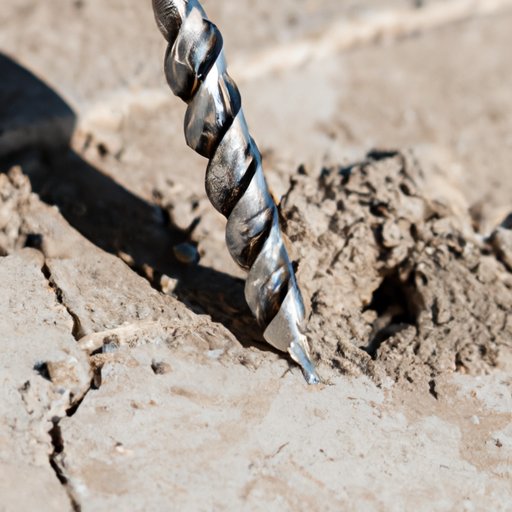
Introduction
Drilling into concrete is a crucial skill for any DIY enthusiast or professional builder. Whether you need to install anchors or create a hole for wiring, concrete drilling is an essential technique that requires patience and the right tools. In this article, we will guide you through the process of drilling into concrete, providing helpful tips and techniques to make the task easier and safer.
Concrete Drilling 101: A Beginner’s Guide
Before you start drilling into concrete, it’s essential to understand the key terms and tools involved. Concrete is a hard and dense building material that requires special drill bits and techniques to work with effectively. Hammer drills are the most common tools used for concrete drilling, featuring a specialized ability to hammer and rotate simultaneously, making the process smoother and quicker.
When drilling into concrete, ensure that you have the necessary tools available. You will need a hammer drill, a masonry bit, measuring tape, a marker, safety glasses, earplugs, and a dust mask to protect yourself from concrete dust.
Basic techniques for drilling into concrete include first creating a mark where you want your hole to be using a marker. Select the right drill bit, ensuring it is suitable for drilling into concrete, and adjust it on the hammer drill, so it correctly fits. Hold the hammer drill perpendicular to the concrete surface, switch on the drill, and follow through using slow and steady pressure, ensuring that the drill is fully perpendicular to the surface.
The Dos and Don’ts of Drilling into Concrete: Best Practices for Success
Drilling into concrete can be dangerous and tricky, resulting in potential injury or property damage when done incorrectly. It’s essential to follow these best practices for success:
- Wear proper safety gear, including earplugs, safety glasses, gloves, and dust masks to protect yourself from concrete dust.
- Measure carefully before drilling to avoid any mistakes that can result in costly errors.
- Be patient throughout the process, continuously checking and monitoring the depth of the hole.
- Minimize risks by turning off the power and unplugging the drill before changing drill bits or adjusting the hammer drill settings.
5 Proven Techniques for Perfectly Drilling into Concrete
There are different techniques and tools available to drill into concrete, depending on the job’s specifics. Here are five proven techniques for drilling into concrete:
- Pre-drilling a pilot hole: This method helps to guide the drill bit and ensures that it remains stable throughout the drilling process.
- Using a hammer drill: As previously mentioned, this type of drill is designed specifically for drilling into concrete and can complete the job much quicker than a standard drill.
- Using a masonry bit: Masonry bits are designed explicitly for use in drilling into concrete, making it a crucial tool to have when working with this material.
- Other techniques to consider including using a diamond bit, which is suitable for drilling through tougher concrete, and drilling at an angle, which helps when you need to create a larger hole.
Each technique has its advantages and disadvantages, so consider your job’s specifics before selecting which technique to use.
Troubleshooting Concrete Drilling: Common Problems and How to Fix Them
Concrete drilling doesn’t always go smoothly, and it’s essential to know how to troubleshoot common problems to avoid them.
- Overheating the drill bit: This problem occurs when there’s too much friction between the drill bit and the concrete surface, heating up the bit. To fix this, stop drilling and give the bit time to cool down.
- Experiencing excessive blowout: Blowout is when the hole’s edge crumbles unevenly, making it unstable and possibly causing injury. To avoid this issue, use a smaller pilot bit before proceeding to the larger bit and gradually increase the size of the hole.
- Drill bit slipping or getting stuck: This problem can occur when the drill bit isn’t inserted correctly or when it’s blunt. Always ensure that the drill bit is inserted correctly and is sharp before drilling.
The Ultimate Guide to Drilling into Concrete: Tips, Tools, and Techniques
To become an expert in drilling into concrete, you need to select the right tools, learn useful tips, and adopt various techniques to make the job more comfortable and enjoyable.
Start by selecting the right drill bit size for your job. For larger holes, select a bigger bit, and for smaller holes, choose a smaller size. A quality hammer drill that features a clutch and different speed settings can make the drilling process smoother and thus shorten it.
When drilling into concrete, keep the hammer drill as steady as possible, ensuring that the drill’s weight is not pushing it down. You can also create a small reservoir of water around the hole, ensuring that the bit stays cool throughout the drilling process.
Lastly, ensure that you mark the drilling point correctly, give the drill enough time to cool down, and always clean up carefully to avoid any unwanted hazardous accidents from dust and debris.
Conclusion
Drilling into concrete may seem difficult at first, but with the right tools, techniques, and tips, you’ll be amazed at how straightforward and comfortable it can be. Remember to be patient throughout the drilling process, wear proper safety gear, and follow the best practices outlined in this article to ensure success.
By selecting the right drill bit, pre-drilling a pilot hole, and using a hammer drill, you’ll be on your way to becoming an expert in concrete drilling.





